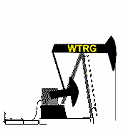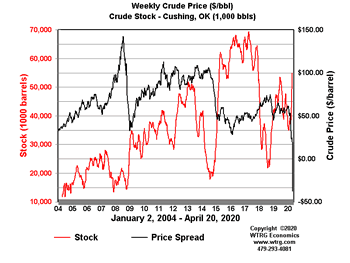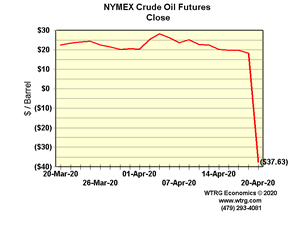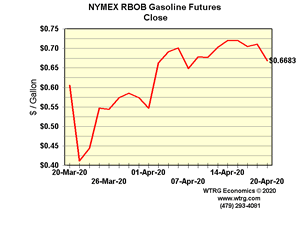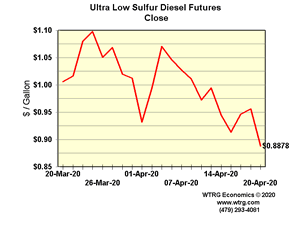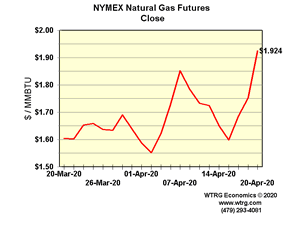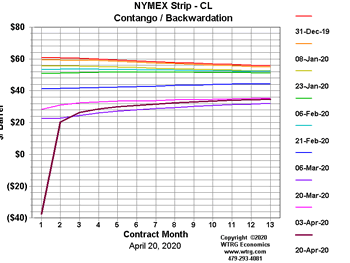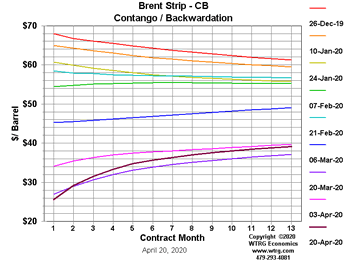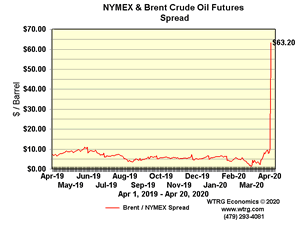Oil Futures go negative
To understand today's $55.90 drop of the May futures price
to -$37.63 per barrel. At no time in the past did oil ever
trade in negative territory.
To understand this unique situation, it is necessary to
focus on the nature of the NYMEX contract. The contract is
for a 1,000 barrels of crude to be delivered to Cushing,
Oklahoma over the course of the contract month. In this
case, we are talking about May. While the exact day of the
month may very a little the last day of trading is on or
before the 22nd of the month previous to the contract month.
In this case it is the 21st. There are probably few
contracts left to trade tomorrow. If bought on margin which
is $7,500 ($7.50 per barrel), with Monday's drop in crude
many could not cover their margins and their contracts were
sold by the brokerage firms.
Most traders who have purchased a futures contract sell it
before the last day of trading. As of last Friday there were
still 109,593 outstanding WTI May contracts. This
represented about 110 million barrels of crude oil.
Since the crude must be delivered to Cushing, the
availability of storage there is critical. Cushing's total
working capacity is 76.093 million barrels and as of the
10th there was 54.965 million barrels leaving 21.128 million
barrels of spare capacity. Which is about a fifth of the
volume represented by the May contracts outstanding on
Friday.
The week of the 10th, 5.724 million barrels was added to
storage at Cushing. At that rate Cushing will be full May
8th. There is clearly not enough storage at Cushing to take
the physical delivery of the 110 million barrels represented
by Friday's outstanding May contracts. The problem is
compounded because most, if not all of the remaining
storage, is already under contract.
With crude in an extreme contango the only companies that
could take advantage were those that have spare storage
capacity at Cushing either because they own the tanks or
more likely that they have already leased that capacity.
It is apparent to the market that the lack of additional
storage capacity will persist through June and July. As of
this writing June contracts are down $9.99 at $11.03 per
barrel and July is off $6.74 at $20.23. The May contract is
actually back in positive territory at $8.23 on its last day
of trading.
We are awash in crude oil and gasoline and jet fuel as well.
Refiners are shutting down and we will gain more insight
into that tomorrow with the EIA's weekly data release.
After a discussion with one of our subscribers, I came to
the obvious conclusion that one of the big pieces of data to
watch is gasoline consumption which is the obvious short
term leading indicator of GDP as it is an indicator of how
many people have returned to work.
The Texas Railroad commission could have added support to
the market and stabilized some of the disparities created by
the excess inventories. Instead it delayed making a
decision. If the June outlook of $11.03 per barrel holds it
is barely enough to cover the lifting cost of oil production
for most of the producers with no money left over for
administration cost.
For your author it is a flashback to Midland in 1986-1988
where the only demand for forecasts came from attorneys for
Chapter 11 reorganizations in bankruptcy courts. Producers
will not be the only folks in bankruptcy courts as owners of
office buildings and apartment complexes will find
themselves in dire straights as the oil companies and
service companies shed employees. The big concern is whether
they will be able to lure their employees back after the
layoffs.
Conclusion
Oil won't recover until people return to work. Even then the
recovery will be slow as rebooting the economy will not be
instantaneous. Furthermore, some employers may find that
some of their workers are more effective working from home.
That means fewer commuters. It will be several years before
gasoline consumption returns to near 10 million b/d.
|
|
